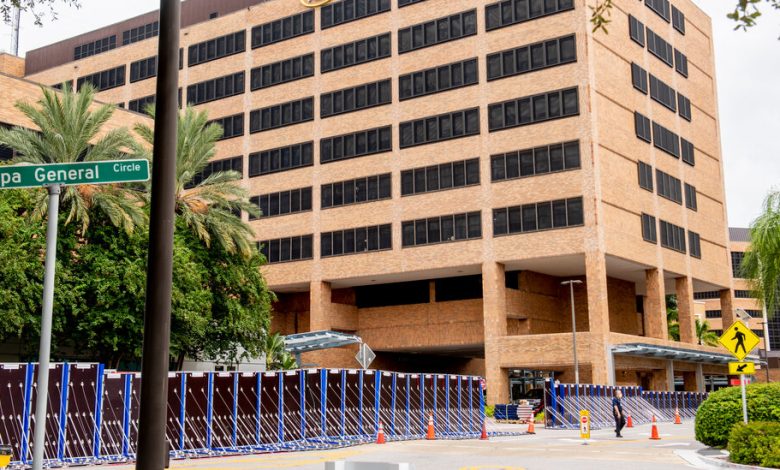Hospitals in Coastal Cities Risk Flooding Even in ‘Weak’ Hurricanes, Study Finds

In a large proportion of the metropolitan areas along the Atlantic and Gulf coasts of the United States, at least half of the hospitals are at risk of flooding even from relatively weak hurricanes, a new study found.
Projected sea level rise is expected to increase the odds of coastal hospital flooding by 22 percent by the end of the century, according to the study, which was published on Thursday, a day after Hurricane Ian made landfall in southwest Florida.
The study comes at a critical moment. Ian, nearly a Category 5 storm, has the potential to end up ranking as one of the most catastrophic hurricanes to strike the United States in the past decade, according to forecasters.
The study found that, in one-third of the 78 metropolitan areas examined, half or more of the hospitals faced flood risk from what the study described as a “relatively weak” hurricane of Category 2. Five of the 10 most threatened metropolitan areas identified in the study are in coastal Florida.
In the southwestern Florida city of Punta Gorda, where Ian made its second landfall on Wednesday, 100 percent of the roads within a mile of a hospital were projected by the researchers to be flooded by a Category 2 storm as ranked on the Saffir-Simpson scale, which goes up to 5.
Read More About Extreme Weather
- Water Crisis: A megafire in New Mexico that displaced thousands of people has set off a drinking water crisis — the latest chapter in a catastrophe created by the federal government when Forest Service employees lost control of two prescribed burns set this spring.
- Drying Waterways: Drought combined with extreme heat across Europe has brought to surface once-submerged ancient treasures, painting a dramatic picture of the continent’s drying rivers and reservoirs.
- Smoke Pollution: Smoke from wildfires has worsened over the past decade, potentially reversing decades of improvements in Western air quality made under the Clean Air Act, according to new research.
- Floods and Climate Change: A new study found that global warming intensified Pakistan’s recent monsoon rains, convincing scientists that rising temperatures were a contributing factor in the floods that devastated the country in August.
Yet as the climate warms, hurricanes have gotten more intense over the past decades, with a larger proportion of them strengthening rapidly from relatively weak storms to Category 4 or 5, sometimes overnight. Hurricanes, fueled by warming ocean water, are also unleashing more rain, a consequence of an atmosphere that, with each degree Celsius of warming, can hold about 7 percent more water vapor.
Powerful winds and devastating flooding can disrupt health care delivery through power outages, supply shortages and limited access to care at a time when hospitals are crucial in caring for the injured, said Dr. Aaron Bernstein, a pediatrician at Boston Children’s Hospital and the interim director of Harvard’s Center for Climate, Health and the Global Environment.
The study is the first to systematically investigate the flood risk to nearly 700 hospitals located within 10 miles of the coast, together serving almost 85 million people, or about a quarter of Americans. Researchers began working on it after Hurricane Harvey battered Texas and Louisiana in 2017 and inundated hospitals, trapped ambulances and grounded medical helicopters.
The authors noted that the Southeast Louisiana Veterans Health Care Center in New Orleans, built to replace a hospital that had been destroyed by Hurricane Katrina, served as a good model for how coastal hospitals could improve their resilience to hurricanes. The facility features backup fuel supplies and on-site sewage treatment, and its critical mechanical and electrical equipment are at least 20 feet above the 100-year floodplain, or the area that would be inundated by a severe flood.
Researchers emphasized, though, that hospital preparedness should not stop at making individual hospitals more resilient. Even if hospital buildings themselves are not flooded, the roads leading to them may still be, effectively cutting off a functional hospital from patients who are trying to reach it, Dr. Bernstein said.
In 18 of the metropolitan areas, at least half of the roads within a mile of the hospitals were at risk of flooding from a Category 2 storm, the researchers said. Hospitals cannot be “a resilient island in a fragile ocean,” said Auroop R. Ganguly, a geosciences and civil engineering professor at Northeastern University who was not involved in the study.
Dr. Bernstein also emphasized that health care providers in some major cities, like New York, Boston and Philadelphia, might face much higher risk than expected. Because of where the hospitals are located and the numbers of hospital beds relative to the populations they serve, when a storm does hit, there will be “more people searching for fewer beds,” he said.
The study contributes to a better understanding of how to characterize the damage that a hurricane can inflict on the communities it hits, said Kristie L. Ebi, a professor in the University of Washington’s Center for Health and the Global Environment who wasn’t involved in the study.
For example, there’s often a perception that much of a hurricane’s damage comes from high winds, Dr. Ebi said, but in reality, it is the flooding that has a much bigger effect on life and property, both during the storm and in its aftermath.
